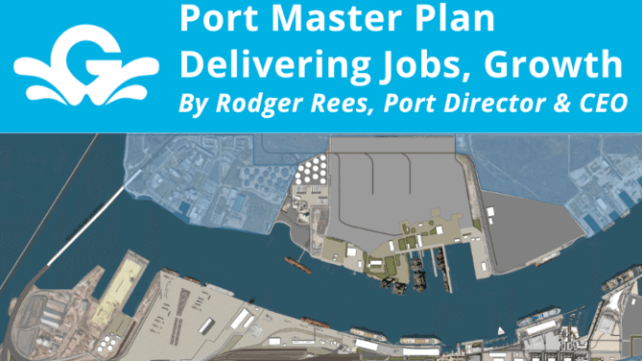20 Year Plan Maps Out Cruise, Cargo, Commercial & Industrial Growth

Our Galveston Wharves Board of Directors recently held a special meeting on the port’s 20-Year Strategic Master Plan to review progress and set priorities. Adopted by the board in 2019, the plan is designed to bring our self-sustaining, citizen-owned port to its fullest potential in terms of revenues, jobs and community benefits.
At the Nov. 30 special meeting, port staff gave the board an update on key areas, including our cruise business sector, Pelican Island, and the West Port Cargo Complex. The key message was “We’re working the plan and the plan is working.”
The board gave staff great feedback and specific direction related to Pelican Island development and cruise growth, including the nod for the port staff to explore potential development of a fourth cruise terminal at piers 16-18.
Cruise Growth for a Stronger Port
As you’ve heard me say before, our cruise business generates 60 percent of port revenues to help us fund critical cargo infrastructure rehabilitation and other projects that create jobs and economic growth. As the cruise industry ramps back up post-pandemic, the port and the community benefit tremendously.
A port-commissioned study by Martin and Associates shows the huge impact the cruise business is having on the local economy in 2022, including:
- 3,489 jobs
- $567.8 million in local business revenue
- $19.7 million in state and local tax revenue
- $1.9 million in business revenue per cruise vessel
- $73.5 million in onshore spending by passengers and crew
The city of Galveston benefits directly with almost $1.5 million annually from the port and its cruise business. That total includes an estimated $900,000 port payment for total passenger movements, $370,000 in sales tax from port parking revenues, and the $180,000 guaranteed port payment. So, you can see that as the port cruise business grows, the city benefits too.
Benefits of a 4th Cruise Terminal
As mentioned earlier, the board gave staff approval to pursue discussions about a public-private partnership with a major international cruise company to develop a fourth cruise terminal at piers 16-18.
The master plan includes another terminal in the 2030-2040 timeframe, but the opportunity has presented itself now. Acreage currently under lease for a cargo operation will come available sooner than expected. Also, cruise lines looking to expand are strongly interested in Galveston. As envisioned in the master plan, the surrounding neighborhoods will benefit from the port’s expanded interior roadway and with attractive landscaped areas replacing the industrial look of stacked containers.
A fourth cruise terminal would boost the local economy annually with an additional 925 jobs, $58.6 million in income, $177 million in revenues, $21 million in onshore spending by passengers and crew, and $5 million in state and local taxes, of which a portion is allocated to the city.
Setting Our Sights on Pelican Island
Almost half of the port’s 840 acres is on Pelican Island. Much of the 357 acres is undeveloped and offers deep-water access. Challenges include the lack of transportation infrastructure and utilities. The board and staff discussed the possibility of public-private partnerships beginning with requests for expressions of interest.
Investing in Cargo for Jobs, Economic Diversity
Our cargo and lay ship businesses don’t generate the same level of revenues as cruise, but they demonstrated their worth during the pandemic. Cargo and lay revenues ensured the port’s economic survival during the 15-month cruise industry suspension.
As a top-50 U.S. cargo harbor, our port’s operations generate 350,000 union labor hours annually. The West End Cargo Complex currently generates between $8 million and $9 million annually. We’ve made investments in the complex to improve infrastructure, but it’s only the beginning.
The master plan prioritizes and estimates costs for critical infrastructure projects resulting from decades of neglect. Some of our berths are literally falling apart. Seven of the 17 berths west of Pier 28 are unusable. Major cargo operations including roll-on/roll-off and wind turbine components are at risk if berths 39/40 and 34 are not rehabilitated within the next few years.
The good news is that we have a solid plan and tremendous support from our board, port partners and the citizens of Galveston.
The products and services herein described in this press release are not endorsed by The Maritime Executive.
